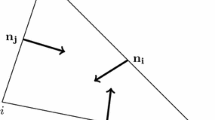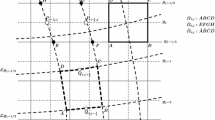Abstract
We propose two tailored finite point methods for the advection–diffusion equation with anisotropic tensor diffusivity. The diffusion coefficient can be very small in one direction in some part of the domain and be discontinuous at the interfaces. When flows advect from the vanishing-diffusivity region towards the non-vanishing diffusivity region, standard numerical schemes tend to cause spurious oscillations or negative values. Our proposed schemes have uniform convergence in the vanishing diffusivity limit, even when the solution exhibits interface and boundary layers. When the diffusivity is along the coordinates, the positivity and maximum principle can be proved. We use the value as well as their derivatives at the grid points to construct the scheme for nonaligned case, which makes it can achieve good accuracy and convergence for the derivatives as well, even when there exhibit boundary or interface layers. Numerical experiments are presented to show the performance of the proposed scheme.











Similar content being viewed by others
References
Arnold, D.N.: An interior penalty finite element method with discontinuous elements. SIAM J. Numer. Anal. 19, 742–760 (1982)
Ashby, S.F., Bosl, W.J., Falgout, R.D., Smith, S.G., Tompson, A.F., Williams, T.J.: A numerical simulation of groundwater flow and contaminant transport on the CRAY T3D and C90 supercomputers. Int. J. High Perform. Comput. Appl. 13(1), 80–93 (1999)
Ern, A., Stephansen, A.F., Zunino, P.: A discontinuous Galerkin method with weighted averages for advection–diffusion equations with locally small and anisotropic diffusivity. IMA J. Numer. Anal. 29, 235–256 (2009)
Han, H., Huang, Z., Kellogg, B.: A tailored finite point method for a singular perturbation problem on an unbounded domain. J. Sci. Comp. 36, 243–261 (2008)
Han, H., Huang, Z.Y.: Tailored finite point method for a singular perturbation problem with variable coefficients in two dimensions. J. Sci. Comput. 49, 200–220 (2009)
Han, H., Huang, Z.Y.: Tailored finite point method for steady-state reaction–diffusion equation. Commun. Math. Sci. 8, 887–899 (2010)
Han, H., Huang, Z.Y.: Tailored finite point method based on exponential bases for convection–diffusion–reaction equation. Math. Comput. 82, 213–226 (2013)
Han, H., Huang, Z.Y., Ying, W.J.: A semi-discrete tailored finite point method for a class of anisotropic diffusion problems. Comput. Math. Appl. 65, 1760–1774 (2013)
Hyman, J., Morel, J., Shashkov, M., Steinberg, S.: Mimetic finite difference methods for diffusion equations. Comput. Geosci. 6, 333–352 (2002)
Herbin,R.,Hubert, F.: Benchmark on discretization schemes for anisotropic diffusion problems on general grids. In: Eymard, R., Herard, J.-M. (eds.) Finite Volumes for Complex Applications V, pp. 659–692. John Wiley & Sons (2008)
Kellogg, R.B., Houde, Han: Numerical analysis of singular perturbation problems. Hemisphere Publishing Corp, USA. Distributed outside North America by Springer-Verlag, pp. 323–335 (1983)
Lipnikov, K., Shashkov, M., Svyatskiy, D., Vassilevski, Yu.: Monotone finite volume schemes for diffusion equations on unstructured triangular and shape-regular polygonal meshes regimes. J. Comput. Phys. 227, 492–512 (2007)
Lipnikov, K., Svyatskiy, D., Vassilevski, Y.: A monotone finite volume method for advection diffusion equations on unstructured polygonal meshes. J. Comput. Phys. 229, 4017–4032 (2010)
Motzkin, T.S., Wasow, W.: On the approximation of linear elliptic differential equations by difference equations with positive coefficients. J. Math. Phys. 31, 253–259 (1953)
Leveque, R.J., Li, Z.L.: The immersed interface method for elliptic equations with discontinuous coefficients and singular sources. SIAM J. Numer. Anal. 31, 1019–1044 (1994)
Oberman, A.M.: Convergent difference schemes for degenerate elliptic and parabolic equations: Hamilton–Jacobi equations and free boundary problems. SIAM J. Numer. Anal. 44(2), 879–895 (2006)
Pasdunkorale, J., Turner, I.W.: A second order control-volume finite-element least-squares strategy for simulating diffusion in strongly anisotropic media. J. Comput. Math. 23, 1–16 (2005)
Sheng, Z.Q., Yue, J.Y., Yuan, G.W.: Monotone finite volume schemes of nonequilibrium radiation diffusion equations on distorted meshes. SIAM J. Sci. Comput. 31(4), 2915–2934 (2009)
Treguier, A.M.: Modelisation numerique pour loceanographie physique. Ann. Math. Blaise Pascal 9(2), 345–361 (2002)
van Esa, B., Koren, B., de Blank, H.J.: Finite-difference schemes for anisotropic diffusion. J. Comput. Phys. 272, 526–549 (2014)
Wu, J.M., Gao, Z.M.: Interpolation-based second-order monotone finite volume schemes for anisotropic diffusion equations on general grids. J. Comput. Phys. 274, 569–588 (2014)
Younes, A., Fontaine, V.: Efficiency of mixed hybrid finite element and multipoint flux approximation methods on quadrangular grids and highly anisotropic media. Int. J. Numer. Methods Eng. 76, 314–336 (2008)
Yuan, G.W., Sheng, Z.Q.: Monotone finite volume schemes for diffusion equations on polygonal meshes. J. Comput. Phys. 227(12), 6288–6312 (2008)
Author information
Authors and Affiliations
Corresponding author
Additional information
Min Tang is partially supported by NSFC 11301336 and 91330203.
Appendix
Appendix
Here, we show that the limiting scheme for the degenerate equation is consist and explain heuristically the monotonicity. We only consider the case when \(\beta _1=\beta _2=0\) and \(\theta \ne 0\). In the limit that \(\epsilon _{i,j}\rightarrow 0\) in (25),
Let the coefficient matrix \(D_k\) in (34) be \((D_k^1,~D_k^2),~k=1,2,3,4\), where \(D_k^i\) (\(i=1,2\)) are \(3\times 1\) columns. We need to show that (34) becomes a consistent and monotone discretization for
Due to the form of \(\gamma _1\), \(\gamma _2\), \(\gamma _3\), (49) can be rewritten as
If we are able to show that when \(\epsilon _{i,j}\rightarrow 0\), the limit of (34) is a discretization to (50), the proof completes.
For the degenerate case we consider here, \(\beta _{1,i,j}=\beta _{2,i,j}=\epsilon _{i,j}=0\), so that \((\lambda _{i,j}, \mu _{i,j})\) in (31) become \((\pm \sqrt{\frac{1}{\alpha \cos ^2\theta }},0)\), \((0,\pm \sqrt{\frac{1}{\alpha \sin ^2\theta }})\). Let
the linear space \(H_{i,j}\) becomes
When \((\lambda _{k,i,j},\mu _{k,i,j})=(\pm \lambda ,0)\), \((\lambda _{k,i,j},\mu _{k,i,j})=(0,\pm \mu )\), (35) are respectively
and (36) are respectively (after dividing some constant)
Let
The subtraction of the two equations in (52), the subtraction of the two equations in (53) and the summation of the two equations in (54), the summation of the two equations in (54) yield a linear system with scalar coefficnets for
Since the right hand side of the subsystem for \(D_{1,1}^1-D_{2,1}^1\), \(D_{3,1}^1-D_{4,1}^1\), \(D_{1,1}^2+D_{2,1}^2\) and \(D_{3,1}^3+D_{4,1}^2\) is zero, we get
The summation of the two equations in (52), the summation of the two equations in (53) and the subtraction of the two equations in (54), the subtraction of the two equations in (54) yield a linear system with scalar coefficients for
which provides the following system for \(g_1\), \(g_2\), \(g_3\), \(g_4\)
The first line of the scheme (34) is
The system (57) can be solved exactly such that
Then by Taylor expansion, when \(\theta \) is away from \(n\pi /2\) (\(n=0,1,2,3\)) and the mesh is fine enough,
-
The second order convergence. Let
$$\begin{aligned} g=\frac{\cosh (\lambda h_x)\cos (\mu h_y)-1}{(\cosh (\lambda h_x)-1)(\cosh (\mu h_y)-1)} \end{aligned}$$Multiplying both sides of (58) by g and using (51), (59), we can obtain
$$\begin{aligned} \begin{aligned}&\displaystyle -\alpha \cos ^2\theta \frac{u_{i+1,j}-2u_{i,j}+u_{i-1,j}}{h_x^2}-\alpha \sin ^2\theta \frac{u_{i,j+1}-2u_{i,j}+u_{i,j-1}}{h_y^2}\\&\displaystyle -2\alpha \sin ^3\theta \cos \theta \frac{\partial _y u_{i+1,j}-\partial _y u_{i-1,j}}{2h_x}-2\alpha \cos ^3\theta \sin \theta \frac{\partial _x u_{i,j+1}-\partial _x u_{i,j-1}}{2h_y}\\&+u_{i,j}=O(h_x^2+h_y^2). \end{aligned} \end{aligned}$$(60)Therefore the limiting scheme is a second order discretization for (50).
-
Heuristic argument about the monotonicity. When \(\theta \) is away from \(n\pi /2\) with \(n=0,1,2,3\), i.e. \(\sin \theta ,\cos \theta \ne 0\), let
$$\begin{aligned} \begin{aligned} \digamma _1&= u_{i+1,j}+\frac{\sin \theta }{\cos \theta }h_x\partial _y u_{i+1,j}-2u_{i,j}+u_{i-1,j}-\frac{\sin \theta }{\cos \theta }h_x\partial _y u_{i-1,j},\\ \digamma _2&= u_{i,j+1}+\frac{\cos \theta }{\sin \theta }h_y\partial _x u_{i,j+1}-2u_{i,j}+u_{i,j-1}-\frac{\cos \theta }{\sin \theta }h_y\partial _x u_{i,j-1},\\ \digamma _3&=\left( g_1-\frac{g_3}{\frac{\sin \theta }{\cos \theta }h_x}\right) \left( u_{i+1,j}+u_{i-1,j}\right) +\left( g_2-\frac{g_4}{\frac{\cos \theta }{\sin \theta }h_y}\right) (u_{i,j+1}+u_{i,j-1})-u_{i,j}. \end{aligned} \end{aligned}$$(61)We can reformulate (58) into
$$\begin{aligned} \displaystyle \frac{g_3}{\frac{\sin \theta }{\cos \theta }h_x}\digamma _1+\frac{g_4}{\frac{\cos \theta }{\sin \theta }h_y} \digamma _2+\digamma _3+\left( 2\frac{g_3}{\frac{\sin \theta }{\cos \theta }h_x}+2\frac{g_4}{\frac{\cos \theta }{\sin \theta }h_y}\right) u_{i,j}=0. \end{aligned}$$(62)According to the definition of monotone schemes for degenerate elliptic equation in [16], in order to have a consist and convergent scheme for the degenerate elliptic equation, we have to show that the coefficients in front of all neighboring grids are positive while the coefficient in front of \(u_{i,j}\) are negative. For simplicity we only consider the case when \(\theta \in (0,\pi /2)\). First of all, \(g_1,g_2,g_3,g_4>0\) in this case.
$$\begin{aligned} \begin{aligned} u_{i+1,j}+\frac{\sin \theta }{\cos \theta }h_x\partial _y u_{i+1,j},\qquad&u_{i-1,j}-\frac{\sin \theta }{\cos \theta }h_x\partial _y u_{i-1,j},\\ u_{i,j+1}+\frac{\cos \theta }{\sin \theta }h_y\partial _x u_{i,j+1},\qquad&u_{i,j-1}-\frac{\cos \theta }{\sin \theta }h_y\partial _x u_{i,j-1} \end{aligned} \end{aligned}$$can be respectively considered as approximations to the function values at \(Z_{i,j}^1\), \(Z_{i,j}^2\), \(Z_{i,j}^3\), \(Z_{i,j}^4\) in Fig. 12. Besides, from (59) and \(g_1,g_2>0\), the coefficients in front of \(u_{i\pm 1,j}\), \(u_{i,j\pm 1}\) in \(\digamma _3\) are positive. Finally, the coefficient in front of \(u_{i,j}\) is \(-1\) which is negative, therefore the limiting scheme is monotone, which gives the convergence of the scheme for the degenerate equation according to [16]. When \(\theta \) is in other quadrant, the discussion is the same.
The approximations in (59) can only be valid the mesh have to be fine enough, especially when \(\theta \) is really close to \(n\pi /2\). One may argue that when \(\theta \) is close to \(n\pi /2\) with \(n=0,1,2,3\), the locations of \(Z_{i,j}^1\), \(Z_{i,j}^2\), \(Z_{i,j}^3\), \(Z_{i,j}^4\) can be far away from the cell. This is not a proof but a heuristic argument. However, the numerical results seem quite promising.
Rights and permissions
About this article
Cite this article
Tang, M., Wang, Y. Uniform Convergent Tailored Finite Point Method for Advection–Diffusion Equation with Discontinuous, Anisotropic and Vanishing Diffusivity. J Sci Comput 70, 272–300 (2017). https://doi.org/10.1007/s10915-016-0254-1
Received:
Revised:
Accepted:
Published:
Issue Date:
DOI: https://doi.org/10.1007/s10915-016-0254-1





